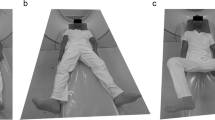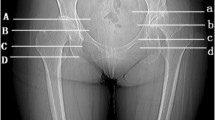Abstract
The aim of this paper was to study the anatomical relationship between the piriformis muscle and the sciatic nerve with regard to the possibility of neurological deficit after THA. The incidence of anatomical variation of both structures is 15–30% in the literature. The authors studied 91 cadavers and found an atypical relationship in 19 cases (20.9%). In this study individual variations were found with the following frequency:
-
The sciatic nerve exits below the piriformis muscle in 79.1% of the cases.
-
The sciatic nerve separates into two divisions above the piriformis, one branch passing through the muscle, the other below it (14.3%).
-
An unsplit nerve passes through the piriformis muscle in 2.2%.
-
The nerve separates into two divisions above the piriformis, one branch exiting above the muscle and passing along its dorsal aspect, the second exiting distally below the muscle in 4.4%.
The most common reasons for sciatic nerve injury in surgery of the hip joint are direct injuries, ischemia of the nerve tissue, compression or excessive distraction of the nerve, compression by bone cement, thermal damage during cement polymerization, injury during THA dislocation, compression by hematoma, bone prominence or an implanted acetabular component. According to the presented anatomical study, overstretching of the nerve itself or its branches in the area of the pelvitrochanteric muscles after their release from their origin can be another mechanism. Such overstretching can appear in the presence of some of the aforementioned anatomical variants.


Similar content being viewed by others
References
Austin SM, Klein GR, Sharkey PF, Hozak WJ, Rothman RH (2004) Late sciatic nerve palsy caused by hematoma after primary total hip arthroplasty. J Arthroplasty 19:790
Beaton LE, Anson JB (1937) The relation of the sciatic nerve and of its subdivisions to the piriformis muscle. Anat Rec 70:1–5
Chiby S (1992) Multiple positional relationships of nerves arising from the sacral plexus to the piriformis muscle in humans. Kaibogaku-Zasshi 67:691–724
De Luca CJ, Bloom LJ, Gilmore LD (1987) Compression induced damage on in-situ severed and intact nerves. Orthopedic 10:777–784
Edwards BN, Tullos HS, Noble PC (1987) Contributory factors and etiology of sciatic nerve palsy in total hip arthroplasty. Clin Orthop 218:136–141
Eggli S, Hankemayer S, Muller ME (1999) Nerve Palsy after leg lengthening in total hip replacement arthroplasty for developmental dysplasia of the hip. J Bone Joint Surg Br 81:843
Katsimihas M, Hutchchinson J, Heath P, Smith E, Travlos J (2002) Delayed transient sciatic nerve palsy after total hip replacement. J Arthroplasty 17:379
Le Double AF (1897) Traité des variations du systéme musculaire de l’homme. C Reinwald, Paris, pp 231–232
Lee Chung-Shiung, Tsai Tsu-Li (1974) The relation of the sciatic nerve to the piriformis muscle. J Formos Med Assoc 73:75–80
Navarro RA, Schmalzried TP, Amstutz HC, Dorey FJ (1995) Surgical approach and nerve palsy in total hip arthroplasty. J Arthroplasty 10:1–5
Nercessian O, Piccoluga F, Eftekhar NS (1994) Postoperative sciatic and femoral nerve palsy with reference to leg lengthening and medialization/lateralization of the hip joint following total hip arthroplasty. Clin Orthop 304:165–170
Parsons FG, Keith A (1897) Sixth annual report of the committee of collective investigation of the anatomical society of Great Britain and Ireland. J Anat Physiol 31:31–44
Schmalzried TP, Amstutz HC, Dorey FJ (1991) Nerve palsy associated with total hip replacement. J Bone Joint Surg 73-A:1074–1080
Simon JP, Van Delm I, Fabry G (1993) Sciatic nerve palsy following hip surgery. Acta Orthop Belg 59:156–162
Testut L (1884) Les anomalies musculaires chez l’home. G. Masson, Paris, pp 585–590
Williams PL (1995) Gray’s anatomy, 38th edn, vol 284. Churchill Livingstone, New York, p 877
Zechmann JP, Reckling FW (1989) Association of preoperative hip motion and sciatic nerve palsy following total hip arthroplasty. Clin Orthop 241:197–199
Acknowledgments
This paper was supported by grant MZO 00064203-6604.
Author information
Authors and Affiliations
Corresponding author
Rights and permissions
About this article
Cite this article
Pokorný, D., Jahoda, D., Veigl, D. et al. Topographic variations of the relationship of the sciatic nerve and the piriformis muscle and its relevance to palsy after total hip arthroplasty. Surg Radiol Anat 28, 88–91 (2006). https://doi.org/10.1007/s00276-005-0056-x
Received:
Accepted:
Published:
Issue Date:
DOI: https://doi.org/10.1007/s00276-005-0056-x




